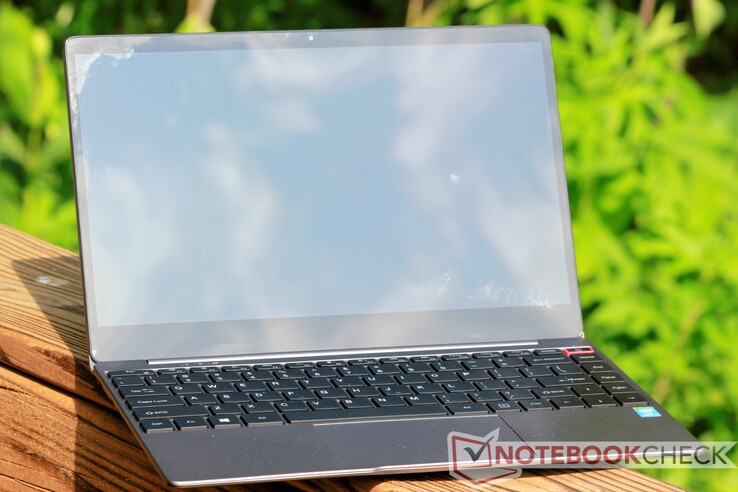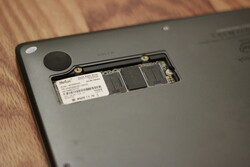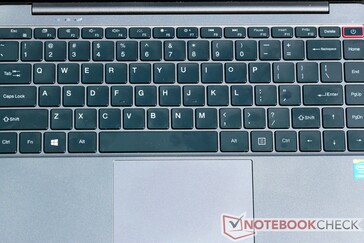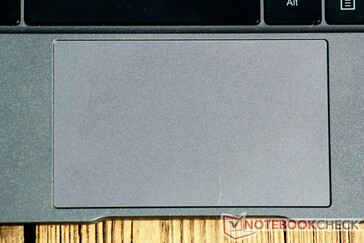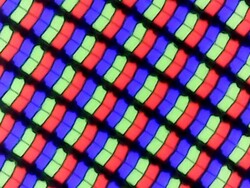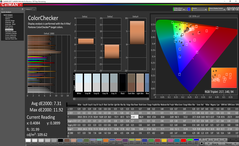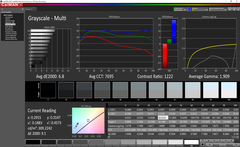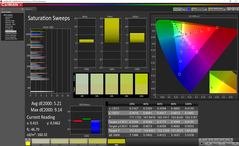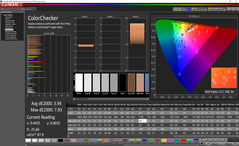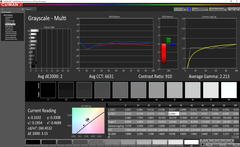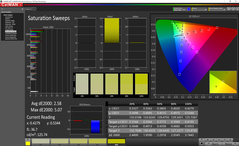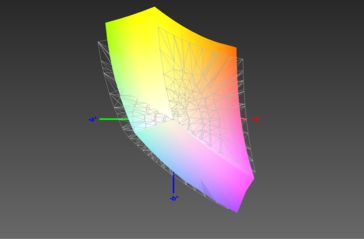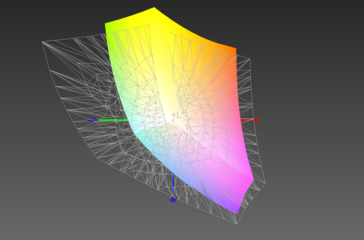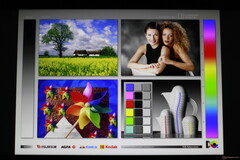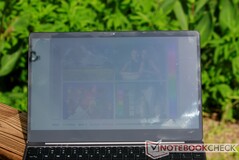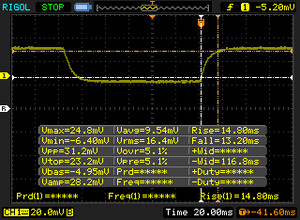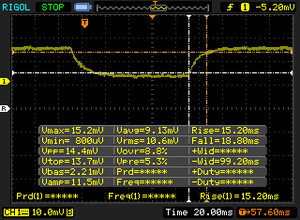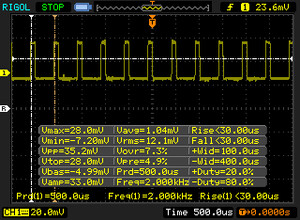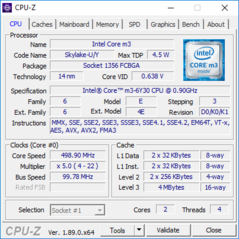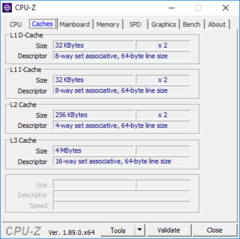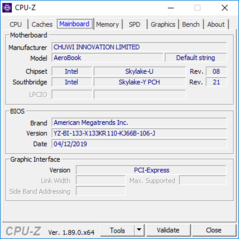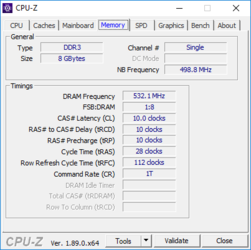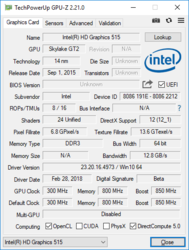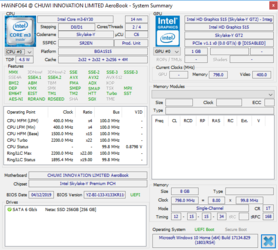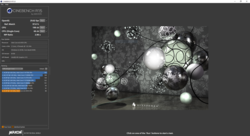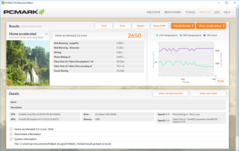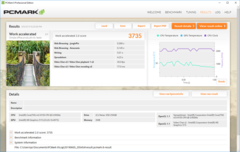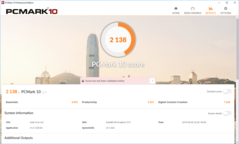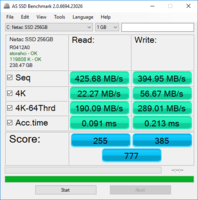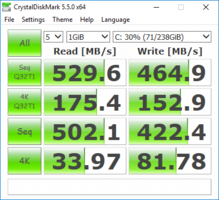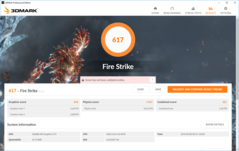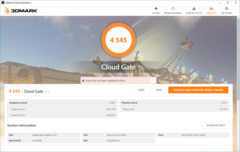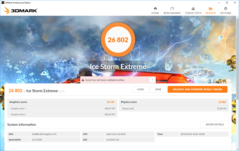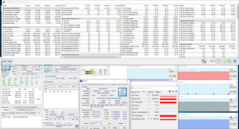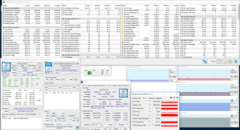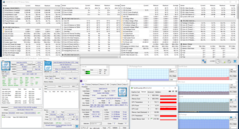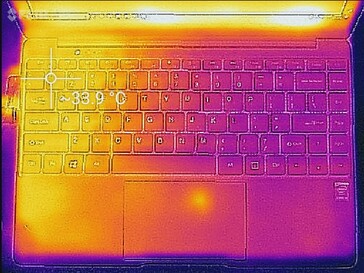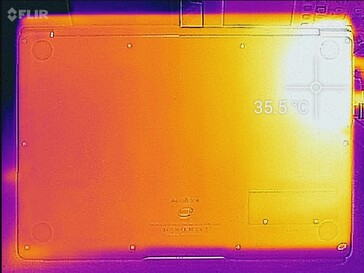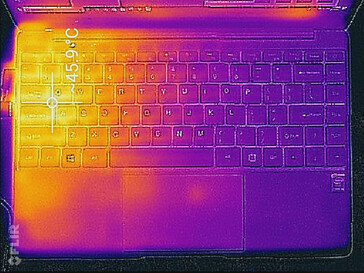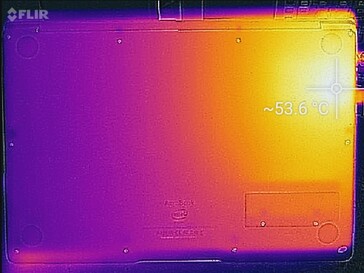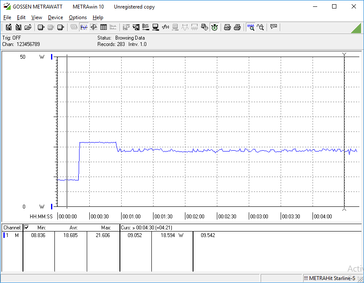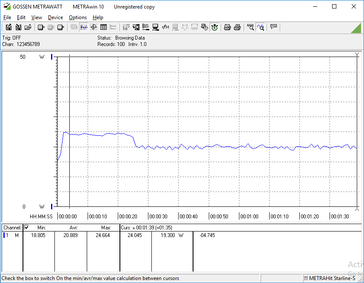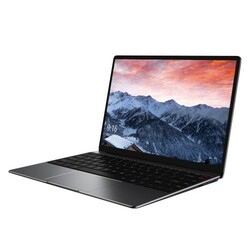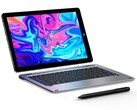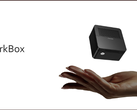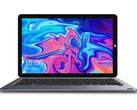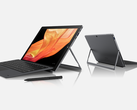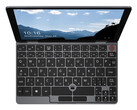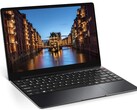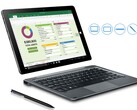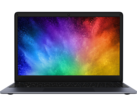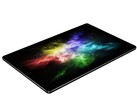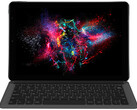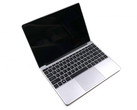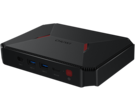Chuwi AeroBook (2019) Laptop Review: A crowdfunded compact Ultrabook

How do you make a laptop that can rival Apple's 12-inch MacBook? If you're Chuwi, you turn to IndieGoGo and ask your userbase to fund the initial costs. The 2019 AeroBook is the product of a crowdfunding campaign launched at the end of February this year. The campaign ultimately raised US $286,846 from 694 backers, far exceeding Chuwi's flex goal of $30,000. Now that the laptop is here, how does it fare?
The AeroBook looks incredibly similar to the 12-inch MacBook, although there are some subtle changes to the design. Sadly, Chuwi also took cues from the internals of the MacBook; the AeroBook uses Intel's Core m3-6Y30, a nearly four-year-old CPU based on the Skylake architecture. We will see how the AeroBook holds up and whether or not it is worth its $500 retail price.
Competitors of the AeroBook include Apple's 12-inch MacBook and the new MacBook Air. On the Windows side, the Dell XPS 13 should also be considered. These machines are more than double the price of the AeroBook, though. Those on a budget should look at the Asus E203MA and Lenovo's IdeaPad 330S. Lastly, Chuwi's own LapBook SE is a worthy contender.
Case
Chuwi borrowed quite a few design elements from Apple for the AeroBook. The laptop is hewn from aluminum and shares a similar industrial look and feel to Cupertino's computers. The keyboard deck is made of plastic masquerading as metal; though they are a cheaper material, the palm rest and keyboard shell look and feel premium. Users will be hard-pressed the deck from the lid and base. The understated Chuwi logo and brushed matte finish go a long way in masking the AeroBook's $500 price tag; this device looks almost as good as an Apple laptop at less than half the cost.
Build quality is also excellent. Gaps are tight and even across the chassis save at the bottom of the clickpad. The lid is rigid and can barely be twisted. The keyboard experiences some flex under directed pressure but remains steady when typing. The bottom panel similarly flexes when squeezed. Overall, the laptop feels well-built for a thin device. It bears repeating: it's hard to hit this level of quality at this price. The hinges are too stiff for one-handed opening but hold the screen in place with no wobble. The display can open to about 135°.
The AeroBook is thinner than most laptops at 16 mm, though the MacBook Air trims another 0.4 mm off. The 12-inch MacBook is almost 3 mm thinner than the AeroBook. Still, the AeroBook is very portable for a 13.3-inch device. The machine comes in at 1.2 kg (2.7 lbs), which is a hair lighter than the MacBook Air and about even with the Dell XPS 13. Users will have no trouble carrying the laptop around all day.
Connectivity
Thankfully, Chuwi did not copy Apple's port selection. The AeroBook is reasonably well-equipped for peripherals. The left side features a USB 3.1 Gen 1 Type-A, the power adapter, a mini-HDMI port, and a USB 3.1 Gen 1 Type-C port. The right side houses another USB 3.1 Gen 1 Type-A port, a headset jack, and a microSD card reader. While the lack of Thunderbolt is noticeable, considering the price, it is to be expected. Our chief complaint is the placement of the power jack. The included power supply uses a right-angle connection, and this can easily block either the adjacent USB or micro-HDMI port.
SD Card Reader
The microSD card reader is slow. The AeroBook manages a mere 10 MB/s in our real-world JPG copy test, which is about six times slower than the average laptop. We should also note that the card reader requires a microSD card to be inserted upside down, which is uncommon.
| SD Card Reader | |
| average JPG Copy Test (av. of 3 runs) | |
| Dell XPS 13 9380 2019 (Toshiba Exceria Pro SDXC 64 GB UHS-II) | |
| Average of class Subnotebook (18.4 - 142, n=14, last 2 years) | |
| Lenovo IdeaPad 330S-15IKB-81F500N5GE (Toshiba Exceria Pro SDXC 64 GB UHS-II) | |
| Chuwi LapBook SE | |
| Chuwi AeroBook 13 inch 2019 (Toshiba Exceria Pro UHS-II SDXC) | |
| maximum AS SSD Seq Read Test (1GB) | |
| Dell XPS 13 9380 2019 (Toshiba Exceria Pro SDXC 64 GB UHS-II) | |
| Average of class Subnotebook (22.5 - 207, n=14, last 2 years) | |
| Asus E203MA-FD825TS (Toshiba Exceria Pro M501 microSDXC 64GB) | |
| Chuwi LapBook SE | |
| Chuwi AeroBook 13 inch 2019 (Toshiba Exceria Pro UHS-II SDXC) | |
Communication
Wireless speeds are slower than the average laptop but should still be fast enough for most home wireless networks. The main sticking point with the Intel Dual Band Wireless-AC 3165 in our unit was reliability; connections remained stable when the router was in an unobstructed line with the device, but the 5 GHz connection could not be made through an external wall. The 2.4 GHz band was still able to connect up to about 20 meters from the router through an interior and an exterior wall.
Maintenance
The AeroBook features a convenient hatch on the bottom panel to replace or upgrade the M.2 SSD. Two small screws hold the panel onto the chassis. There are 9 more Phillips Head #00 screws holding the bottom panel in place, including one hidden behind a warranty sticker. The bottom panel is also secured by some stubborn clips and the ports along the side. As such, we did not remove the bottom for fear of damaging the laptop.
Input Devices
Keyboard
The oversized keyboard is fairly comfortable to type upon. Key travel is average and feels similar to most other keyboards. Feedback feels stiff; there is a definite pressure point, and the key action is rigid due to a firm and responsive spring. This, in turn, generates clatter. Overall, the keyboard is good and most will find it comfortable after a short period of adjustment. The addition of dedicated navigation keys (Home, End, Page Up, Page Down) along the right side is a plus.
One complaint we have concerns the arrow key arrangement; while it is nice that the AeroBook has full-sized arrow keys, Chuwi shortened the right shift key to accommodate the layout. This will be frustrating to some typists.
Touchpad
The touchpad is large and offers a generous amount of space. The smooth surface feels premium underhand, and glide is easy. Tracking is responsive, and the clicking mechanism feels firm. The AeroBook uses Windows Precision drivers, and we have no complaints about cursor response. As mentioned, there is a slight gap along the bottom of the touchpad which may collect dirt and grime over time.
Display
The display is a definite strength of the laptop. The screen is bright at about 295 nits (300 nits is the average for modern laptops). The backlight is evenly distributed (90%), and contrast is good. Blacks look deep and shades of gray are easy to distinguish. There is PWM at 99% brightness and below, but at 2000 Hz, it's unlikely to bother most. Overall, the AeroBook's screen competes well with other laptops, but Apple's MacBook Air and Dell's XPS 13 offer brighter and more pixel-dense panels.
| |||||||||||||||||||||||||
Brightness Distribution: 90 %
Center on Battery: 307.6 cd/m²
Contrast: 905:1 (Black: 0.34 cd/m²)
ΔE ColorChecker Calman: 7.31 | ∀{0.5-29.43 Ø4.78}
calibrated: 3.94
ΔE Greyscale Calman: 6.8 | ∀{0.09-98 Ø5}
87% sRGB (Argyll 1.6.3 3D)
57% AdobeRGB 1998 (Argyll 1.6.3 3D)
64.1% AdobeRGB 1998 (Argyll 3D)
87.6% sRGB (Argyll 3D)
67.3% Display P3 (Argyll 3D)
Gamma: 1.909
CCT: 7695 K
| Chuwi AeroBook 13 inch 2019 BOE BOE0719, IPS, 13.3", 1920x1080 | Apple MacBook Air 2018 APPA039, IPS, 13.3", 2560x1600 | Asus E203MA-FD825TS AUO225C, TN LED, 11.6", 1366x768 | Lenovo IdeaPad 330S-15IKB-81F500N5GE BOE0700, IPS, 15.6", 1920x1080 | Apple MacBook 12 2017 APPA027, LED IPS, 12", 2304x1440 | Chuwi LapBook SE 13.3", 1920x1080 | Dell XPS 13 9380 2019 ID: AUO 282B B133ZAN Dell: 90NTH, IPS, 13.3", 3840x2160 | |
|---|---|---|---|---|---|---|---|
| Display | 7% | -43% | -37% | 3% | 1% | ||
| Display P3 Coverage (%) | 67.3 | 67.8 1% | 35.75 -47% | 39.85 -41% | 65 -3% | 64.7 -4% | |
| sRGB Coverage (%) | 87.6 | 96.1 10% | 53.8 -39% | 58.8 -33% | 94.8 8% | 93.1 6% | |
| AdobeRGB 1998 Coverage (%) | 64.1 | 69.8 9% | 36.94 -42% | 41.17 -36% | 66.5 4% | 65.3 2% | |
| Response Times | -8% | 22% | -20% | -12% | -7% | -50% | |
| Response Time Grey 50% / Grey 80% * (ms) | 34 ? | 39.6 ? -16% | 41 ? -21% | 44 ? -29% | 40.8 ? -20% | 39.2 ? -15% | 58 ? -71% |
| Response Time Black / White * (ms) | 28 ? | 28 ? -0% | 10 ? 64% | 31 ? -11% | 29.2 ? -4% | 27.7 ? 1% | 36 ? -29% |
| PWM Frequency (Hz) | 2000 ? | 113600 ? | 86000 ? | 116000 | 200 ? | ||
| Screen | 37% | -36% | -8% | -9% | 23% | ||
| Brightness middle (cd/m²) | 307.6 | 320 4% | 235 -24% | 283 -8% | 227 -26% | 404 31% | |
| Brightness (cd/m²) | 295 | 315 7% | 227 -23% | 252 -15% | 210 -29% | 389 32% | |
| Brightness Distribution (%) | 90 | 95 6% | 93 3% | 75 -17% | 89 -1% | 85 -6% | |
| Black Level * (cd/m²) | 0.34 | 0.29 15% | 0.44 -29% | 0.63 -85% | 0.44 -29% | 0.37 -9% | |
| Contrast (:1) | 905 | 1103 22% | 534 -41% | 449 -50% | 516 -43% | 1092 21% | |
| Colorchecker dE 2000 * | 7.31 | 1.2 84% | 11.73 -60% | 4.02 45% | 6.6 10% | 3.72 49% | |
| Colorchecker dE 2000 max. * | 11.92 | 3.2 73% | 18.8 -58% | 8.77 26% | 12.2 -2% | 7.38 38% | |
| Colorchecker dE 2000 calibrated * | 3.94 | 0.5 87% | 3.73 5% | 4.03 -2% | 1.9 52% | 2.06 48% | |
| Greyscale dE 2000 * | 6.8 | 0.8 88% | 12.64 -86% | 0.8 88% | 7.9 -16% | 4.44 35% | |
| Gamma | 1.909 115% | 2.2 100% | 2.61 84% | 2.35 94% | 2.16 102% | 2.34 94% | |
| CCT | 7695 84% | 6548 99% | 14819 44% | 6552 99% | 8879 73% | 7095 92% | |
| Color Space (Percent of AdobeRGB 1998) (%) | 57 | 62.1 9% | 34 -40% | 38 -33% | 60 5% | ||
| Color Space (Percent of sRGB) (%) | 87 | 96 10% | 54 -38% | 58 -33% | 93 7% | ||
| Total Average (Program / Settings) | 12% /
26% | -19% /
-30% | -22% /
-15% | -12% /
-12% | -4% /
-6% | -9% /
10% |
* ... smaller is better
Color accuracy is average. The average DeltaE2000 scores for colors and grays sit at 7.31 and 6.8, respectively. (DeltaE2000 scores of 3 or less are generally considered acceptable for professional work.) As such, the AeroBook is not well-suited for projects that depend on accurate color. However, the AeroBook's screen is more than accurate enough for content consumption. Calibration vastly improves color accuracy, but Apple's devices (especially the MacBook Air) are far better options for color work. There is also a slight blue shift to the screen due to the higher color temperature (7695 K), but calibration corrects this.
The IPS display offers excellent viewing angles with images remaining clear and colors remaining accurate up to about 175°. The glossy finish does present a problem: reflections. Indoors under normal lighting, reflections are not visible. However, under bright lights or outdoors, smudges across the glass and reflections can obscure displayed images. The AeroBook is not well-suited to outdoor use. Backlight bleed is minimal.
Display Response Times
| ↔ Response Time Black to White | ||
|---|---|---|
| 28 ms ... rise ↗ and fall ↘ combined | ↗ 14.8 ms rise | |
| ↘ 13.2 ms fall | ||
| The screen shows relatively slow response rates in our tests and may be too slow for gamers. In comparison, all tested devices range from 0.1 (minimum) to 240 (maximum) ms. » 70 % of all devices are better. This means that the measured response time is worse than the average of all tested devices (20.2 ms). | ||
| ↔ Response Time 50% Grey to 80% Grey | ||
| 34 ms ... rise ↗ and fall ↘ combined | ↗ 15.2 ms rise | |
| ↘ 18.8 ms fall | ||
| The screen shows slow response rates in our tests and will be unsatisfactory for gamers. In comparison, all tested devices range from 0.165 (minimum) to 636 (maximum) ms. » 45 % of all devices are better. This means that the measured response time is similar to the average of all tested devices (31.6 ms). | ||
Screen Flickering / PWM (Pulse-Width Modulation)
| Screen flickering / PWM detected | 2000 Hz | ≤ 99 % brightness setting | |
The display backlight flickers at 2000 Hz (worst case, e.g., utilizing PWM) Flickering detected at a brightness setting of 99 % and below. There should be no flickering or PWM above this brightness setting. The frequency of 2000 Hz is quite high, so most users sensitive to PWM should not notice any flickering. In comparison: 53 % of all tested devices do not use PWM to dim the display. If PWM was detected, an average of 8111 (minimum: 5 - maximum: 343500) Hz was measured. | |||
Performance
While the AeroBook looks great on the outside, looks can be deceiving; the laptop is powered by painfully outdated hardware. The AeroBook can handle simple office tasks and web browsing reasonably well, but heavier loads will bring the system to its knees and try the patience of users.
Processor
The Intel Core m3-6Y30 powering the AeroBook is an odd choice. The Skylake CPU is now almost four years old, and it wasn't known for its performance when it was released in 2015. The dual-core hyperthreaded chip falls behind most competitors. Even Asus' inexpensive E203MA beats the AeroBook thanks to its capable Pentium Silver N5000 CPU. It's likely Chuwi decided on the Core m3-6Y30 to lower costs; the manufacturer may have been able to secure a stockpile of the chips from Intel's surplus. As a final kick in the teeth, the older platform only supports DDR3 memory. On the plus side, long-term performance is very stable.
The Core m3-6Y30 does have a benefit; the CPU is fanless, and the AeroBook is completely silent. Overall, the device has a similar use case to that of Apple's MacBook - it is capable for most office work and general web browsing, but heavier CPU-reliant tasks are no-gos.
| Cinebench R11.5 | |
| CPU Single 64Bit | |
| Average of class Subnotebook (1.89 - 3.62, n=11, last 2 years) | |
| Average Intel Core m3-6Y30 (0.81 - 1.04, n=6) | |
| Chuwi LapBook SE | |
| CPU Multi 64Bit | |
| Average of class Subnotebook (14.8 - 34.3, n=11, last 2 years) | |
| Average Intel Core m3-6Y30 (1.79 - 2.4, n=6) | |
| Chuwi LapBook SE | |
| Cinebench R10 | |
| Rendering Multiple CPUs 32Bit | |
| Average of class Subnotebook (14395 - 51374, n=11, last 2 years) | |
| Average Intel Core m3-6Y30 (6194 - 7355, n=4) | |
| Chuwi LapBook SE | |
| Rendering Single 32Bit | |
| Average of class Subnotebook (2299 - 10697, n=11, last 2 years) | |
| Average Intel Core m3-6Y30 (3286 - 3477, n=4) | |
| Chuwi LapBook SE | |
| wPrime 2.10 - 1024m | |
| Average Intel Core m3-6Y30 (788 - 864, n=3) | |
| Chuwi LapBook SE | |
| Average of class Subnotebook (145.3 - 1250, n=8, last 2 years) | |
* ... smaller is better
System Performance
Overall performance is adequate but falls short in some areas. Office work can be done smoothly and very light graphical work is possible (simple photo edits with three or fewer layers). However, the machine quickly runs into limits. Streaming 4K video results in stutters every few seconds. The AeroBook can chug through simple spreadsheets, but larger worksheets (5000+ rows) will cause slowdowns, as will complex formulas like nested IFs. Video editing is also off the table. Essentially, the AeroBook is good enough for writing papers and managing small data sets but runs out of steam with anything heavier.
The AeroBook falls toward the back of the pack in PCMark 8 and PCMark 10. Those that need more power should look at a laptop with a full-fledged Core i3 or Core i5 CPU, like the Lenovo IdeaPad 330s or Dell XPS 13.
| PCMark 8 Home Score Accelerated v2 | 2650 points | |
| PCMark 8 Work Score Accelerated v2 | 3735 points | |
| PCMark 10 Score | 2138 points | |
Help | ||
Storage Devices
The 256 GB Netac SSD is fairly good considering the price of the laptop. Read and write speeds are average for a SATA III-based SSD and should be adequate for most users. The AeroBook's chipset does support NVMe drives on paper, although we were unable to test an NVMe drive to see how speeds may be affected by the rest of the system. The drive can easily be swapped via the dedicated panel on the bottom.
| Chuwi AeroBook 13 inch 2019 Netac SSD 256GB | Apple MacBook Air 2018 Apple SSD AP0256 | Apple MacBook 12 2017 Apple SSD AP0256 | Asus E203MA-FD825TS SanDisk DA4064 | Lenovo IdeaPad 330S-15IKB-81F500N5GE | Chuwi LapBook SE SanDisk DF4032 | Dell XPS 13 9380 2019 SK hynix PC401 HFS256GD9TNG | Average Netac SSD 256GB | |
|---|---|---|---|---|---|---|---|---|
| CrystalDiskMark 5.2 / 6 | 113% | 99% | -59% | 19% | -78% | 99% | -7% | |
| Write 4K (MB/s) | 81.8 | 118 44% | 95.7 17% | 38.28 -53% | 11.17 -86% | 84.6 3% | 86 ? 5% | |
| Read 4K (MB/s) | 33.97 | 29.97 -12% | 22.8 -33% | 12.14 -64% | 7.2 -79% | 38.52 13% | 23.2 ? -32% | |
| Write Seq (MB/s) | 422.4 | 1000 137% | 867 105% | 220.2 -48% | 158.1 -63% | 87.7 -79% | 557 32% | 364 ? -14% |
| Read Seq (MB/s) | 502 | 1218 143% | 940 87% | 262 -48% | 892 78% | 247 -51% | 1393 177% | 432 ? -14% |
| Write 4K Q32T1 (MB/s) | 152.9 | 232.1 52% | 342 124% | 45.72 -70% | 162.2 6% | 12.29 -92% | 339.5 122% | 188.9 ? 24% |
| Read 4K Q32T1 (MB/s) | 175.4 | 254 45% | 437.5 149% | 61 -65% | 320.4 83% | 32.46 -81% | 255.4 46% | 185.9 ? 6% |
| Write Seq Q32T1 (MB/s) | 464.9 | 1001 115% | 1085 133% | 167.1 -64% | 160.2 -66% | 92 -80% | 558 20% | 398 ? -14% |
| Read Seq Q32T1 (MB/s) | 530 | 2555 382% | 1634 208% | 211.5 -60% | 933 76% | 150.1 -72% | 2541 379% | 456 ? -14% |
GPU Performance
The integrated Intel HD Graphics 515 is not known for its graphical prowess. As such, light photo editing is possible, but video edits or 3D modeling are not feasible. Additionally, 720p or 1080p video can be streamed relatively smoothly, but higher resolutions result in consistent stutters. As mentioned, 4K video playback via YouTube is not possible. On paper, the AeroBook can support up to two additional screens. We were able to test a single 1080p monitor in addition to the laptop's display, and both displays were supported.
| 3DMark 11 Performance | 1121 points | |
| 3DMark Cloud Gate Standard Score | 4145 points | |
| 3DMark Fire Strike Score | 617 points | |
Help | ||
Gaming Performance
Similarly, gaming on the AeroBook is possible, but expectations should be tempered. Older titles and less-demanding games like Bioshock Infinite and Rocket League are playable at the lowest settings and resolutions. Indie titles like Stardew Valley and Undertale are (as expected) smooth. More demanding 3D games and newer titles are far out of reach.
| low | med. | high | ultra | |
|---|---|---|---|---|
| BioShock Infinite (2013) | 32 | 13 | ||
| Rocket League (2017) | 28 | 11 | ||
| Team Fortress 2 (2017) | 42 | 30 | 14 |
Emissions
System Noise
The AeroBook is fanless, and there is thus no noise under any load. Coil whine is present but is only audible up to about 8 inches from the keyboard.
Temperature
The AeroBook's chassis stays near room temperature under light load. When pressed, the notebook's left side warms up, particularly along the palm rest. The upper-right corner of the bottom gets noticeably hot under load. This is to be expected, as this spot rests directly above the fanless CPU. As such, the AeroBook should be kept on a table or desk when pushing the laptop (e.g., streaming HD video).
Stress Test
The AeroBook cannot keep its cool under stress. Despite the low 900 MHz base clock of the Core m3 6Y30 CPU, the system still throttles under sustained system load. Using Prime95 to strain the CPU, the chip does fairly well, maintaining an average clock of 1.8 GHz while boosting intermittently to 2.0 GHz. It should be noted that the CPU does not reach its rated boost of 2.2 GHz. Graphical stress cripples the AeroBook. Running FurMark throttles the CPU back below its base clock, and the integrated Intel HD Graphics 515 suffers in equal measure.
| CPU Clock (GHz) | GPU Clock (MHz) | Average CPU Temperature (°C) | Average GPU Temperature (°C) | |
| Prime95 Stress | 1.8 | - | 74 | - |
| FurMark Stress | 0.8 | 600 | 76 | 76 |
| Prime95 + FurMark Stress | 700 | 550 | 77 | 77 |
(±) The maximum temperature on the upper side is 44 °C / 111 F, compared to the average of 35.9 °C / 97 F, ranging from 21.4 to 59 °C for the class Subnotebook.
(-) The bottom heats up to a maximum of 53.4 °C / 128 F, compared to the average of 39.3 °C / 103 F
(+) In idle usage, the average temperature for the upper side is 31.9 °C / 89 F, compared to the device average of 30.8 °C / 87 F.
(±) The palmrests and touchpad can get very hot to the touch with a maximum of 36.2 °C / 97.2 F.
(-) The average temperature of the palmrest area of similar devices was 28.2 °C / 82.8 F (-8 °C / -14.4 F).
Speakers
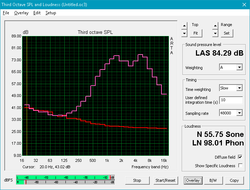
The speakers are bad, even by laptop standards. Our chief complaint is the thin profile and tinny timbre. The lack of bass is painfully obvious, and the thin chassis leaves no room for resonance. Overall, the sound profile is weak. To their credit, the speakers remain clear up to 100% volume, and there is no noticeable distortion.
Chuwi AeroBook 13 inch 2019 audio analysis
(±) | speaker loudness is average but good (76.7 dB)
Bass 100 - 315 Hz
(-) | nearly no bass - on average 23% lower than median
(+) | bass is linear (5.2% delta to prev. frequency)
Mids 400 - 2000 Hz
(±) | higher mids - on average 8.5% higher than median
(±) | linearity of mids is average (12.7% delta to prev. frequency)
Highs 2 - 16 kHz
(±) | higher highs - on average 8.6% higher than median
(±) | linearity of highs is average (11.2% delta to prev. frequency)
Overall 100 - 16.000 Hz
(-) | overall sound is not linear (37.3% difference to median)
Compared to same class
» 97% of all tested devices in this class were better, 2% similar, 1% worse
» The best had a delta of 5%, average was 18%, worst was 53%
Compared to all devices tested
» 94% of all tested devices were better, 1% similar, 5% worse
» The best had a delta of 4%, average was 24%, worst was 134%
Apple MacBook Air 2018 audio analysis
(±) | speaker loudness is average but good (75 dB)
Bass 100 - 315 Hz
(±) | reduced bass - on average 8.1% lower than median
(±) | linearity of bass is average (10% delta to prev. frequency)
Mids 400 - 2000 Hz
(+) | balanced mids - only 2.9% away from median
(+) | mids are linear (5.6% delta to prev. frequency)
Highs 2 - 16 kHz
(+) | balanced highs - only 2.2% away from median
(+) | highs are linear (4.5% delta to prev. frequency)
Overall 100 - 16.000 Hz
(+) | overall sound is linear (12.3% difference to median)
Compared to same class
» 15% of all tested devices in this class were better, 5% similar, 80% worse
» The best had a delta of 5%, average was 18%, worst was 53%
Compared to all devices tested
» 10% of all tested devices were better, 2% similar, 88% worse
» The best had a delta of 4%, average was 24%, worst was 134%
Apple MacBook 12 2017 audio analysis
(+) | speakers can play relatively loud (83.9 dB)
Bass 100 - 315 Hz
(-) | nearly no bass - on average 15% lower than median
(±) | linearity of bass is average (8.8% delta to prev. frequency)
Mids 400 - 2000 Hz
(+) | balanced mids - only 2% away from median
(+) | mids are linear (3.8% delta to prev. frequency)
Highs 2 - 16 kHz
(+) | balanced highs - only 2.3% away from median
(+) | highs are linear (3.3% delta to prev. frequency)
Overall 100 - 16.000 Hz
(+) | overall sound is linear (11.6% difference to median)
Compared to same class
» 12% of all tested devices in this class were better, 3% similar, 85% worse
» The best had a delta of 5%, average was 18%, worst was 53%
Compared to all devices tested
» 7% of all tested devices were better, 2% similar, 90% worse
» The best had a delta of 4%, average was 24%, worst was 134%
Energy Management
Power Consumption
One of the positive points of the Intel Core m3-6Y30 is its low 4.5 Watt TDP. While it lacks power, the chip is fairly efficient. Under load, the system draws an average of 20 Watts. The included power supply is rated for 24 Watts; while the AeroBook hits a peak of 28.6 Watts in our testing, this is a brief spike and shouldn't be cause for concern.
| Off / Standby | |
| Idle | |
| Load |
|
Key:
min: | |
| Chuwi AeroBook 13 inch 2019 6Y30, HD Graphics 515, Netac SSD 256GB, IPS, 1920x1080, 13.3" | Apple MacBook Air 2018 i5-8210Y, UHD Graphics 617, Apple SSD AP0256, IPS, 2560x1600, 13.3" | Apple MacBook 12 2017 m3-7Y32, HD Graphics 615, Apple SSD AP0256, LED IPS, 2304x1440, 12" | Asus E203MA-FD825TS Pentium N5000, UHD Graphics 605, SanDisk DA4064, TN LED, 1366x768, 11.6" | Lenovo IdeaPad 330S-15IKB-81F500N5GE i5-8250U, UHD Graphics 620, , IPS, 1920x1080, 15.6" | Chuwi LapBook SE Celeron N4100, UHD Graphics 600, SanDisk DF4032, , 1920x1080, 13.3" | Dell XPS 13 9380 2019 i5-8265U, UHD Graphics 620, SK hynix PC401 HFS256GD9TNG, IPS, 3840x2160, 13.3" | |
|---|---|---|---|---|---|---|---|
| Power Consumption | 7% | 28% | 49% | -9% | 26% | -36% | |
| Idle Minimum * (Watt) | 4.6 | 2.2 52% | 2 57% | 1.9 59% | 5 -9% | 2.7 41% | 4.8 -4% |
| Idle Average * (Watt) | 7.8 | 5.7 27% | 5.4 31% | 3.5 55% | 7.6 3% | 6.3 19% | 8.6 -10% |
| Idle Maximum * (Watt) | 8.9 | 10.3 -16% | 6.6 26% | 3.9 56% | 8.6 3% | 7.6 15% | 10.4 -17% |
| Load Average * (Watt) | 20.9 | 25.6 -22% | 22 -5% | 12.7 39% | 25.6 -22% | 12.6 40% | 37.9 -81% |
| Load Maximum * (Watt) | 28.6 | 30.6 -7% | 20 30% | 19 34% | 34 -19% | 24.6 14% | 48.5 -70% |
* ... smaller is better
Battery Life
Battery life is average. The 38 Wh battery lasted just over 6 hours in our WiFi test (screen set to 150 nits, opening a new web page every 30-40 seconds). While almost good enough to get through a full workday, most competitors lasted far longer in the same test. Additionally, the battery takes about 3 hours to charge from 5-100% while the system is idle. This is very long, especially for a laptop that draws such little power.
| Chuwi AeroBook 13 inch 2019 6Y30, HD Graphics 515, 38 Wh | Apple MacBook Air 2018 i5-8210Y, UHD Graphics 617, 50.3 Wh | Apple MacBook 12 2017 m3-7Y32, HD Graphics 615, 41.4 Wh | Asus E203MA-FD825TS Pentium N5000, UHD Graphics 605, 38 Wh | Lenovo IdeaPad 330S-15IKB-81F500N5GE i5-8250U, UHD Graphics 620, 52 Wh | Chuwi LapBook SE Celeron N4100, UHD Graphics 600, 37 Wh | Dell XPS 13 9380 2019 i5-8265U, UHD Graphics 620, 52 Wh | |
|---|---|---|---|---|---|---|---|
| Battery runtime | 54% | 45% | 34% | 14% | 130% | 53% | |
| Reader / Idle (h) | 9.3 | 12.6 35% | 17.2 85% | ||||
| WiFi v1.3 (h) | 6.2 | 11.1 79% | 9 45% | 8.3 34% | 5.8 -6% | 7.4 19% | 8.3 34% |
| Load (h) | 1.7 | 2.2 29% | 1.9 12% | 5.8 241% | 2.4 41% |
Pros
Cons
Verdict
Chuwi's AeroBook is a decent clone of Apple's 12-inch MacBook. The Chinese notebook gets several things right; the design is top-notch, the build quality is excellent, and the keyboard and trackpad are very good considering the $500 price tag.
Unfortunately, like the MacBook 12, the AeroBook fails to impress in terms of power. Additionally, Chuwi cannot rely on software optimization like the MacBook can. While Apple's compact laptop can power through 4K video streaming and decently complex office work thanks to optimizations in MacOS, the AeroBook falls short in these tasks and is ultimately relegated to the same use cases as Chromebooks and other cheap Windows laptops.
Overall, the Chuwi Aerobook is a good-looking laptop made for light content consumption, writing notes, and basic office work. Anything heavier will leave users wanting (and waiting for) more.
Interested buyers can save $30 by using the coupon code "CHUWINOTE" at the Amazon link here.
Please note: We updated this review on 09/26/2019 to our new rating version 7. The former rating according to version 6 was at 83 %. If you would like to learn more about our new rating system please click here.
Chuwi AeroBook 13 inch 2019
- 09/26/2019 v7 (old)
Sam Medley




